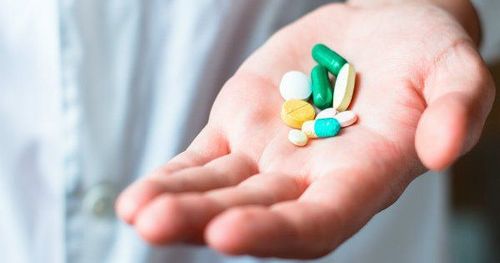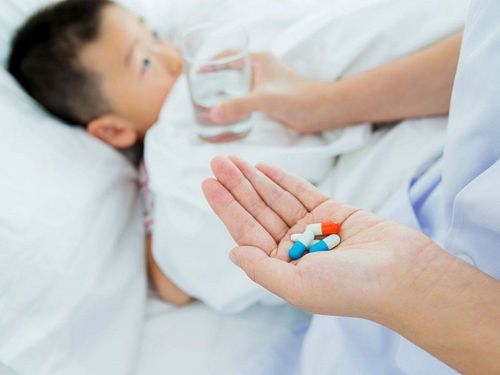This is an automatically translated article.
Polydexa belongs to the group of antibiotics and antibacterial drugs. Currently, it is often prescribed by doctors to treat otitis externa. To better understand the uses and ingredients of the drug, let's learn about ear polydexa in the following article to understand more about what nodon is and how to use polydexa ear drops effectively.
1. What are polydexa ear drops?
Polydexa - a product of Pharmaceutical company Laboratoires Bouchara-Recordati - FRANCE, has the main ingredients are Neomycin sulfate, Dexamethasone sodium metasulphobenzoate, Polymyxin B sulphate and excipients such as Thiomersal, Sodium hydroxide, Macrogol 400, citric acid, Polysorbate 80, Pure water.The drug is prepared in the form of ear drops, capacity of 10.5ml. Polydexa is indicated for the local treatment of otitis externa caused by infection (especially eczema) with intact tympanic membrane.
* Mechanism of action of some main ingredients
- Neomycin
+ Absorption: little is absorbed from the gastrointestinal tract and mainly used for local treatment due to its high toxicity to the auditory nerve and kidney. commonly used by pharmaceutical manufacturers in combination with polymyxin and bacitracin.
+ Distribution: Neomycin is less bound to plasma proteins, and is diffused mainly into the extracellular fluid. + Elimination: Neomycin is eliminated mainly by the kidneys, excreted in the urine.
Polymyxin B sulfate + Absorption: Polymyxin B sulfate is not absorbed from the gastrointestinal tract, except for young children, up to 10% of the dose can be absorbed; Mainly well absorbed through the peritoneum. Distribution: widely distributed throughout the body, no studies have found distribution in the cerebrospinal fluid (even when the meninges are inflamed) and does not cross the placenta. Polymyxin B is also not highly bound to plasma proteins. Elimination: The serum half-life of Polymyxin B in adults with normal renal function is from 4.3 to 6 hours. Approximately 60% of the absorbed drug into the body is eliminated in the urine through glomerular filtration as unchanged drug. In adults, within 12 to 24 hours after the initial dose, very little polymyxin B was detected in the urine, most likely due to the drug binding to phospholipids in the renal cell membranes. The drug continues to be excreted for 24 to 72 hours after the last dose. In young children, polymyxin B is excreted more rapidly than in adults; 40 to 60% of the drug absorbed into the body will be excreted within 8 hours in the urine. Peritoneal dialysis or hemodialysis does not significantly remove polymyxin B. Polymyxin B is preferred for topical use, which can be used alone or in combination with other compounds for the treatment of eye and ear infections. and some other infections. Systemic administration is not recommended because polymyxin B is very nephrotoxic.
2. Indications for polydexa ear drops
2.2. Polydexa is contraindicated in the following cases:
Allergy to neomycin, dexamethasone, polymyxin B or any of the excipients listed above. The patient has a perforated eardrum. The outer ear is infected with a virus (typically chickenpox or herpes). 2.3. Caution when using ear polydexa It is recommended that you check the integrity of your eardrum before using the drug (usually an Ear - Nose - Throat specialist will order an otoscopy to check). If your eardrum is not checked accidentally and your eardrum is punctured, it is very likely that the medicine will come into contact with the structures of the middle ear and cause irreversible toxic effects (such as: deafness and loss of balance). Discontinue use immediately if skin rash occurs or any signs of local or systemic allergic reaction. It is not recommended to use Polydexa concurrently with other ear drops. For the intended use, this ear drop solution is not intended for injection or ingestion. When using ear drops, be careful not to touch your finger or ear to the tip of the dropper to reduce the risk of infection. Athletes should be advised to use this medication as it contains an active ingredient (dexamethasone) which can give positive results in sports stimulant tests. If the patient does not improve after 10 days of treatment, the patient should be re-examined to re-evaluate his condition and have an appropriate treatment. This medicine should only be used during pregnancy on the advice of your doctor. If pregnancy is found, a doctor should be consulted as only a doctor can assess the need for treatment. 2.4. Common side effects of polydexa ear drops Specific local reactions in the ear (irritation), antibiotic allergy (polymyxin B, neomycin). Patients at risk of eczema and allergic reactions; skin irritation due to Polydexa containing thimerosal in the excipients. If not screened properly and the patient's eardrum is perforated, it will result in deafness and loss of balance. Development of fungal infections and selection of resistant bacteria. 2.5. Drug Interactions Drugs that may interact with Polydexa include:
Bromocriptine: use in combination with Polydexa may increase blood pressure Guanethidine (Antihypertensives) MAO inhibitors: when combined with Polydexa will increase the risk of high blood pressure for the patient; Cyclopropane, Halothane: when combined with Polydexa will increase the risk of ventricular fibrillation Bepridilom, sparfloxacin, aminoglutethimide, halofantrine, terfenadine sultopride, vincamine, astemizole, erythromycin, pentamidine: when combined with Polydexa may cause negative effects unwanted to your heart.
3. How to use polydexa . ear drops
3.1. How to use polydexa ear drops For topical use. Drop directly into the ear. How to install the dropper: + Cut the dropper cover.
+ Open the vial cap by pulling the metal piece in the direction of the arrow, when the metal ring is separated, remove the vial cap.
+ Insert the dropper into the vial.
+ Remove the dropper cap.
+ Do not squeeze the dropper too hard.
+ You can warm the medicine bottle in your hand for a few minutes before using it to avoid unpleasant sensations caused by the ear contact with the cold solution.
To put drops in the ear: Tilt your head over the painless ear so that the painful ear is facing up. Put a few drops of medicine in the painful ear. Gently pull on the earlobe several times so that the medicine flows deep into the ear canal. Hold your head tilted for about 5 minutes. When the head is straight again, some medicine may come out, dry with absorbent paper. Close the dropper cap after use. Discard the vial at the end of the treatment period; Do not keep the rest of the medicine for future use. 3.2. Dosage of polydexa ear drops Adults: 1 - 5 drops, 2 times a day.
Children: 1-2 drops, depending on age, 2 times/day.
Put the medicine in the affected ear in the morning and evening.
The duration of treatment is usually 7 days.
Please dial HOTLINE for more information or register for an appointment HERE. Download MyVinmec app to make appointments faster and to manage your bookings easily.













